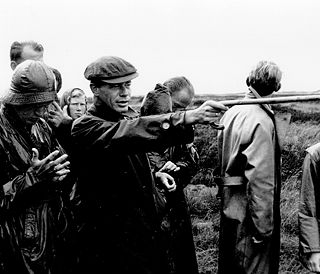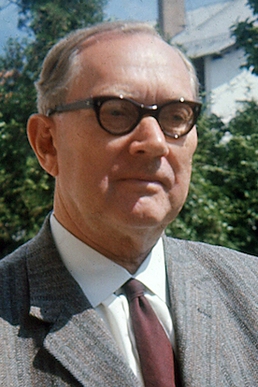External links
- Dansk Botanisk Arkiv at HathiTrust Digital Library
- Dansk Botanisk Arkiv at Botanical Scientific Journals
| Discipline | Botany |
|---|---|
| Language | English |
| Publication details | |
| History | 1913–present |
| Standard abbreviations | |
| ISO 4 | Dan. Bot. Ark. |
Dansk Botanisk Arkiv was a Danish scientific journal or monograph series concerning botany, issued by the Danish Botanical Society. It was published from 1913 to 1980.
Articles were written in Danish, German, English and French. The synonym Res Botanicae Danicae was printed on the front page of some issues.
In 1980, it was fused with Botaniska Notiser Supplement under the name Opera Botanica , which since then has been the monograph series of the Nordic Journal of Botany .

Christen Christensen Raunkiær was a Danish botanist, who was a pioneer of plant ecology. He is mainly remembered for his scheme of plant strategies to survive an unfavourable season and his demonstration that the relative abundance of strategies in floras largely corresponded to the Earth's climatic zones. This scheme, the Raunkiær system, is still widely used today and may be seen as a precursor of modern plant strategy schemes, e.g. J. Philip Grime's CSR system.

Johannes Iversen was a Danish palaeoecologist and plant ecologist.

Tyge Wittrock Böcher was a Danish botanist, evolutionary biologist, plant ecologist and phytogeographer.
Botanisk Tidsskrift was a Danish mixed scientific and amateur journal concerning botany, issued in Copenhagen by the Danish Botanical Society. It was published from 1866 to 1980, when it fused with Botaniska Notiser, Friesia and Norwegian Journal of Botany to form the Nordic Journal of Botany.

Botaniska Notiser was a Swedish scientific periodical concerning botany, issued in Lund, by Societate botanica Lundensi or [Lunds Botaniska Förening]. It was published from 1839 to 1980, when it fused with Botanisk Tidsskrift, Friesia and Norwegian Journal of Botany to form the Nordic Journal of Botany. In 2001, the journal reappeared as a regional journal for botany in south Sweden.

Carl Emil Hansen Ostenfeld was a Danish systematic botanist. He graduated from the University of Copenhagen under professor Eugenius Warming. He was a keeper at the Botanical Museum 1900–1918, when he became professor of botany at the Royal Veterinary and Agricultural University. In 1923, by the early retirement of Raunkiær's, Ostenfeld became professor of botany at the University of Copenhagen and director of the Copenhagen Botanical Garden, both positions held until his death in 1931. He was a member of the Royal Danish Academy of Sciences and Letters and served on the board of directors of the Carlsberg Foundation.
Olaf Hagerup was a Danish botanist. He studied botany at the University of Copenhagen from 1911 under the professors Eugenius Warming, Christen C. Raunkiær, L. Kolderup Rosenvinge og W. Johannsen. He took his Ph.D. from the same university in 1930. From 1934 to 1960, he was superintendent at the Botanical Museum of the University of Copenhagen.
Fredrik Christian Emil Børgesen was a Danish botanist and phycologist. He graduated in botany from the University of Copenhagen and was subsequently employed as an assistant at the Botanical Museum (1893–1900). His doctoral thesis dealt with the marine algae of the Faroe Islands (1904). Later, he became librarian at the Library of the Botanical Garden (1900–1935).
Ernst Vilhelm Østrup was a Danish botanist and phycologist, mainly working on diatoms.
Johannes Boye Petersen was a Danish botanist and phycologist, mainly working on diatoms.
Johannes Grøntved was a Danish botanist. He made investigations of flora and vegetation in Denmark, the Faroe Islands, Iceland, Greenland and Estonia. He was editor of The Botany of Iceland from vol. 3 part 2.
Henning Eiler (Ejler) Petersen was a Danish mycologist, botanist and marine biologist. He made a major contribution to unveiling the mysterious die-back of eel grass in Northern European waters in the early 20th century as a pathogen outbreak.
Knud Morten Lange was a Danish mycologist and politician.
Gunnar Nygaard was a Danish phycologist, and a leading authority on the ecology and taxonomy of Danish phytoplankton. Nygaard completed his master's at University of Copenhagen, initially working at the Freshwater Biological Laboratory in Hillerød as a research stipendiary. From 1933 until his retirement in 1972 he was employed as a lecturer in the Danish grammar school system. Thereafter, he was provided an office at the Freshwater Biological Laboratory to facilitate his work. In recognition of his scientific contributions, the University of Copenhagen awarded him the degree dr. scient. honoris causa.
Hjalmar Frederik Christian Kiærskou, sometimes also stated as Hjalmar Kiaerskov, was a Danish botanist.
Hagbard Jonassen was a Danish botanist, quaternary geologist, war resister and nuclear disarmament proponent. He made a lasting impact on the interpretation of pollen diagrams, including the use of modern pollen deposition in moss polsters to aid interpretation and the consideration of pollen productivity in different types of vegetation.
Frits Ferdinand Rudolf Heide was a Danish botanist and science writer. He studied botany at the University of Copenhagen from 1906 under professor Eugenius Warming, but never actually graduated. In 1909, Frits Heide revised J.P. Jacobsen’s translation of Charles Darwin's On the Origin of Species and The Descent of Man. He also translated Darwin's autobiography into Danish. Much later, in 1935, he finally published his own translation of the Origin of Species. Heide was a prolific writer in Danish popular science, but also contributed with more purely scientific texts on plant biology, forest history, ethnobotany etc. He also served as a private teacher. From around 1920, he was as a consultant for the Dutch government in Java, still publishing botanic works in Danish, Dutch and English on the side. He also founded and edited the journal Journal de Botanique Historique 1918-21.

Tricholoma populinum, commonly known as the poplar tricholoma, sandy, or cottonwood mushroom, is a mushroom of the agaric genus Tricholoma. It was formally described by Danish mycologist Jakob Emanuel Lange in 1933. It is traditionally eaten by the Salish Native Americans in British Columbia.

Gunnar Bror Fritiof Degelius was a Swedish lichenologist. Between the publications of his first and final scientific papers, Degelius had a 70-year-long research career. While he was best known for his expertise on the lichen genus Collema, he also wrote important papers on lichen biology and ecology, floristic studies of the Nordic countries and various other areas around the world, and lichen succession. Degelius described 124 new taxa, and published about 130 scientific papers. In 1992 he was one of the first to be awarded the Acharius Medal for his lifetime contributions to lichenology. Fifteen species and three genera have been named in honour of Degelius.
Anders Munk was a Danish mycologist. He was an expert of the fungal group colloquially known as the Pyrenomycetes, and best known for his 1957 work "Danish Pyrenomycetes".